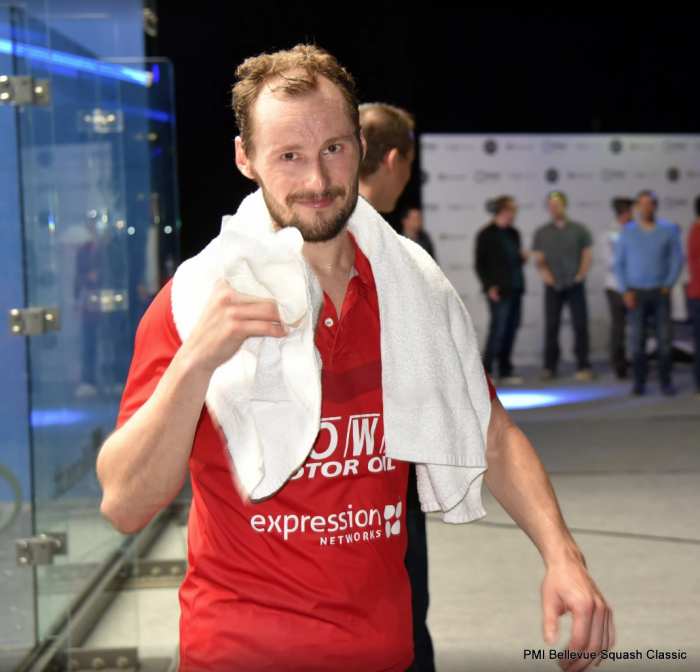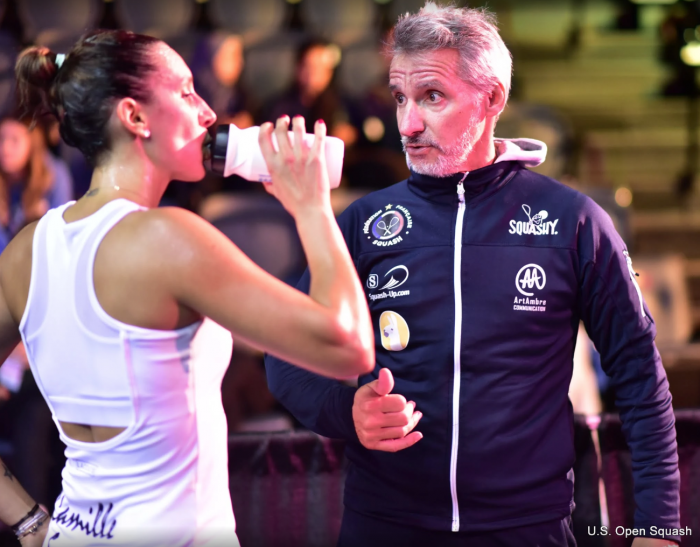With Summer in full swing and temperatures rising in many parts of the world, the issue of how to successfully play and train in the heat without fatigue compromising health and performance becomes an important one. This is of particular importance to squash players, where extreme heat on court is already a very familiar concern.
Gyms, sports halls, and particularly squash courts can be sweltering at this time of year, with temperatures (and often humidity also) rising to extreme levels. While a lot of players choose to rest or at least wind back their squash-related activity at this time of year, for some they are either unable or unwilling to take any kind of extended break.
 Extreme heat can be debilitating to any athlete, regardless of age or level, if they do not take the proper precautions. Sessions that may have felt perfectly comfortable in milder weather, can suddenly become hugely exhausting in hotter conditions. A lot of this is down to ‘thermal regulation’ – as core temperature increases, the body actively moderates the rate of exercise. Physiological changes occur that limit performance – this can mean that despite feelings to the contrary, often it’s not actually that the muscles themselves are getting tired any more prematurely, but that the body slows/stops us as a kind of ‘safety mechanism’ when exposed to extreme heat, causing our ‘Rate of Perceived Exertion’ (RPE) to become much higher.
Extreme heat can be debilitating to any athlete, regardless of age or level, if they do not take the proper precautions. Sessions that may have felt perfectly comfortable in milder weather, can suddenly become hugely exhausting in hotter conditions. A lot of this is down to ‘thermal regulation’ – as core temperature increases, the body actively moderates the rate of exercise. Physiological changes occur that limit performance – this can mean that despite feelings to the contrary, often it’s not actually that the muscles themselves are getting tired any more prematurely, but that the body slows/stops us as a kind of ‘safety mechanism’ when exposed to extreme heat, causing our ‘Rate of Perceived Exertion’ (RPE) to become much higher.
It has also been suggested in studies that the body has a kind of ‘anticipatory’ response to higher temperatures – meaning in hotter conditions, our bodies actually keep us slower from the start. The brain will moderate our pace to avoid us pushing on too hard or fast – when this mechanism fails or is overridden by overzealous efforts, heat exhaustion or heat stroke can occur.
If certain precautions are taken and considerations made for training when the heat is rising however, some of the more draining effects can at least be controlled for somewhat. Here are 4 things to consider:
1. Pace Yourself
Your body will naturally attempt to moderate your intensity levels in hotter environments, and it’s important that you take heed of this and not try and stubbornly push on too hard and attempt to consciously override this mechanism when training.
While league/tournament matches may still have to be played, certainly training sessions can be adapted – attempting to beat your 100 court sprint time during a heatwave is probably not a wise strategy, for example, so think about the temperature/humidity and what kind of a session is best suited to those conditions.
On days with particularly hot weather, concentrating more on some technique based sessions can be a great idea, as the extra bounciness of the ball will also encourage you to develop more control. If you can slot a drop shot in on a hot court with a super bouncy ball, going back to doing it on a more normal, cooler court will seem easy.
2. Hydrate Yourself
Water is crucial to just about every function in the body, including temperature regulation, nerve-impulse conduction, metabolism, and immune system activity. Being even 1-2% dehydrated can result in performance decrements of around 5% – both physical AND mental, so it’s not just your athletic performance that deteriorates, but your ability to make sound shot choices and correct tactical decisions.
 Keeping well hydrated in hotter weather then is crucial, as a lot of sweat will be lost as your body attempts to cool off and regulate temperature. Water is fine most of the time, but during/after particularly tough or lengthy sessions, electrolytes will also need to be replaced through sports drinks or specially prepared beverages.
Keeping well hydrated in hotter weather then is crucial, as a lot of sweat will be lost as your body attempts to cool off and regulate temperature. Water is fine most of the time, but during/after particularly tough or lengthy sessions, electrolytes will also need to be replaced through sports drinks or specially prepared beverages.
3. Cool Yourself
Using active methods to stay cooler can go a long way toward extending performance and time to fatigue.
Keeping cool before your session, not overdoing your warm-up, using cold flannels/ice bags before games/training and again during breaks, staying in the shade if training outside, and wearing suitable clothing and changing into fresh garments when they become sodden with sweat, can all help keep you working for longer.
Also, think about the time of day when you’re playing/training – generally the lunchtime/early afternoon period is the hottest when the sun is out blazing, so try and shift sessions to earlier in the morning, or later in the evening.
4. Adapt Yourself
Allowing yourself time to adapt to increased heat, means that you will be more able to maintain a level of effort and performance closer to that of regular conditions.
Gradually increasing the volume and intensity of your training over the course of a week or two of being exposed to hotter court/gym temperatures, means you will be better able to cope with the conditions as your body is given time to become used to them.
Players who live in hotter climates year-round are obviously then going to be far less affected by the heat than the standard Northern European person thrust into the midst of a heatwave, as they have become way more accustomed to those conditions over the course of time.
As with anything in health and sport, one of the most important things is to always listen to your body. Always be wary when playing in very hot conditions that you take heed of the signals that your body as sending you – if you are feeling unwell or suffering from any kind of out-of-the-ordinary physical responses, slow down or stop your session straight away. Extreme overheating can be very dangerous indeed – always be sure to immediately consult a doctor if you have become ill during or after prolonged heat exposure.
Gary Nisbet
B.Sc.(Hons), CSCS, NSCA-CPT, Dip. FTST
SquashSkills Fitness & Performance Director
Finding hot court conditions tricky?
Check out the excellent series from Lee Drew explaining all you need to know about the tactics needed for playing on a hot court.
Watch Now